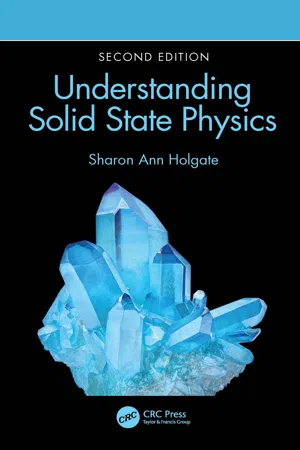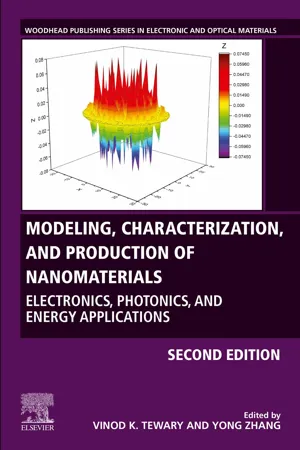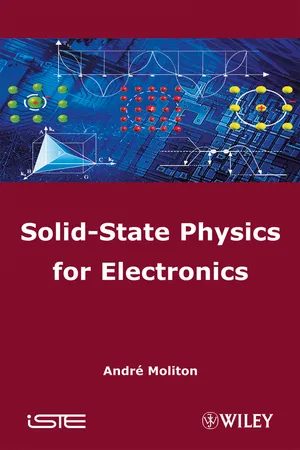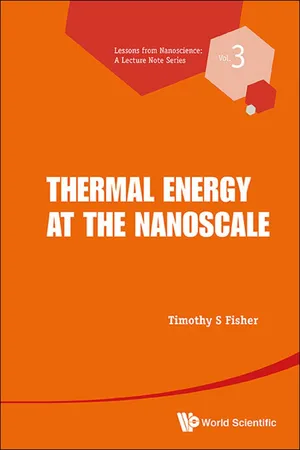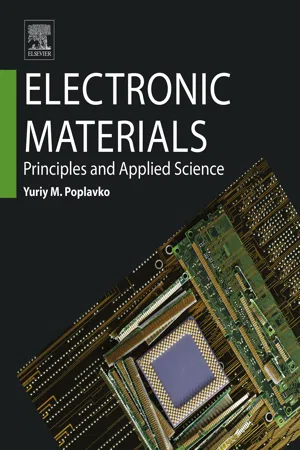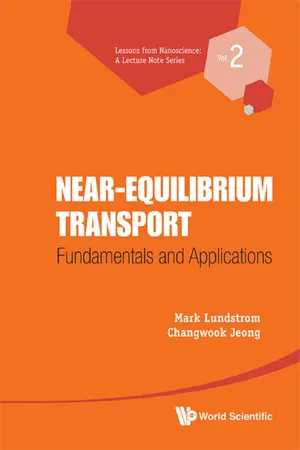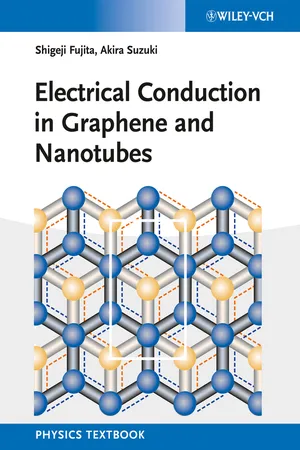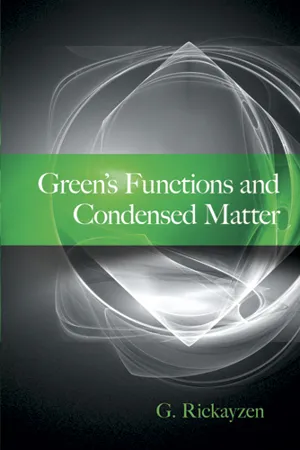Physics
Phonon
A phonon is a collective excitation or quantized mode of vibration in a periodic, elastic arrangement of atoms or molecules in a solid material. It is a fundamental concept in condensed matter physics, describing the vibrational and thermal properties of materials. Phonons play a crucial role in phenomena such as heat conduction, thermal expansion, and superconductivity.
Written by Perlego with AI-assistance
Related key terms
Related key terms
1 of 4
Related key terms
1 of 3
12 Key excerpts on "Phonon"
- eBook - ePub
- Sharon Ann Holgate(Author)
- 2021(Publication Date)
- CRC Press(Publisher)
In fact, a Phonon vibrating at a frequency ω can only have values of energy that are ħ ω apart from one another. If a Phonon is thought of as a quantised packet of vibratory energy, a region of a solid containing larger amplitude atomic vibrations than another area can be said to contain more Phonons. Equally, if a solid is considered as a whole, the greater the atomic vibrations are throughout the solid, the more Phonons are said to be in the solid. The particle nature of Phonons means they can be considered to “move” through solids, and many properties of solids that are affected by temperature can be explained in terms of Phonons being scattered. This scattering can either be by point defects or dislocations, by one another, or by the surface of the solid. In each case, there will be a mean free path, l, which represents how far a Phonon travels on average before being scattered. (The concept of the mean free path is used in many different areas of physics, and it reveals the average distance that a particle travels in a medium before either decaying or undergoing some sort of interaction.) Like all moving objects, Phonons have a wavelength associated with them (see Section D1 of Appendix D for more on wave-particle duality), and the extent to which Phonons are scattered by lattice defects depends on the temperature of the solid they are in because Phonons have different wavelengths at different temperatures. There is actually a range of Phonon wavelengths at all temperatures, but on average, the Phonon wavelength is longer at low temperatures and shorter at high temperatures. In fact as a very rough guide, the dominant Phonon wavelength can be considered to be in the order of a few hundred atomic spacings just above absolute zero, while at room temperature and above, it is around twice the value of the lattice parameter, a - eBook - ePub
Foundations of Solid State Physics
Dimensionality and Symmetry
- Siegmar Roth, David Carroll(Authors)
- 2019(Publication Date)
- Wiley-VCH(Publisher)
To see the extent of this idea, we must first put together everything we have learned about Phonons (lattice vibrations) because these characteristics will limit exactly how such vibrational modes are allowed to interact with heat energy. So recall from above, we know…- Phonons are quantized, meaning they carry energy in discrete chunks. We can picture this classically as discrete vibrational amplitudes at specific frequencies allowed by the lattice. As more quanta of energy are added to a specific vibrational mode, the larger amplitude of vibration gets. We say that we have more Phonons of this mode ω.
- Phonons carry no real momentum; they carry crystal momentum. But we still refer to this momentum as though it were the same as a particle of mass moving at some velocity. It has the restriction of only taking on values within the first Brillouin Zone.
- Phonons interact with other particles by obeying conservation laws. We treat Phonons as though they are a particle (called a quasiparticle) born of the collective nature of the dynamics of many things within the crystal. These Phonon particles obey the laws of being particles for the most part: they conserve momentum and energy when they interact, for instance. Moreover, like the quantum mechanical particle in a box, these Phonon quasiparticles have quantum states they occupy, allowed by the lattice and generally orthogonal to each other (available modes of vibration in the lattice). However, we have not adequately described the filling of these quantum Phonon states (which we enumerated with a K in our derivations above); do we treat these quasiparticles as fermions or bosons? That is, exactly how many Phonons can we pack into any state?4 We have said that as we add quanta of energy to a given mode, the vibrational amplitude of that mode increases and that this is equivalent to adding Phonons. But is there a limit to how many Phonons of a specific mode (ω) are allowed? And how does nature choose to fill up these modes for some finite amount of heat energy Q? This we have not yet explored.
- Finally Phonons are not localized in space
- eBook - ePub
Nanostructured Semiconductors
Amorphization and Thermal Properties
- Konstantinos Termentzidis, Konstantinos Termentzidis(Authors)
- 2017(Publication Date)
- Jenny Stanford Publishing(Publisher)
r independent quantized quasi-particles or waves, called Phonons or normal modes of vibration, whose occupation number obeys the Bose-Einstein statistics.A Phonon is a collective displacement of ions, defined by- a wave vector, , giving the propagation direction of the lattice distortion;q →
- a polarization vector , giving the direction of the atomic motion with respect to the propagation vector In the long‐ wavelength limit, i.e.,e →q →, the two vectors are mutually perpendicular and parallel for shear (transverse) waves and compression (longitudinal) waves, respectively For each wave vector there are two possible independent transverse polarizations;q →→ 0
- a dispersion relation, ω, relating the Phonon’s angular frequency ω , to its wave vector and defining a group velocity . In the Debye approximation, the dispersion relation is linear ωv(= d w / dq →)q →where v(=q →)v sqsis the average sound velocity;
- a lifetime, τ , measuring the average time a given Phonon exists before colliding with defects, Phonons, electrons, etc.
The Phonon states are obtained by diagonalizing the 3r linear coupled differential equations of atomic motion whose determinant is the so‐called dynamical matrix,D (q →) - eBook - ePub
Modeling, Characterization, and Production of Nanomaterials
Electronics, Photonics, and Energy Applications
- Vinod Tewary, Yong Zhang(Authors)
- 2022(Publication Date)
- Woodhead Publishing(Publisher)
☆L. Lindsaya ; T. Pandeyba Materials Science and Technology Division, Oak Ridge National Laboratory, Oak Ridge, TN, United Statesb Department of Physics, University of Antwerp, Antwerp, BelgiumAbstract
The vibrational properties of nanomaterials play fundamentally important roles in determining their stability and various functionalities, from rippling of otherwise flat two-dimensional (2D) monolayers to the extreme thermal transport behaviors observed in one-dimensional (1D) and 2D carbon-based systems. Here we discuss modeling efforts to understand how Phonons in lower dimensional materials differ from those in bulk, and how these behaviors manifest in their unusual properties. In particular, this chapter gives a heavy focus to calculations of Phonon dynamics, interactions, and lattice thermal transport in 1D chains and nanotubes, 2D monolayers, and van der Waals coupled bulk materials from first principles methods. This chapter will discuss important Phonon calculation details related to nanomaterials with examples and discussions providing both historical and modern perspectives.Keywords
Phonons; Thermal conductivity; First principles; Boltzmann transport; NanoscaleAcknowledgments
This research was supported by the US Department of Energy, Office of Science, Basic Energy Sciences, Materials Sciences and Engineering Division with computational resources from the National Energy Research Scientific Computing Center (NERSC), a DOE Office of Science User Facility supported by the Office of Science of the US Department of Energy under Contract No. DE-AC02-05CH11231.6.1: Introduction
“Graphene” in particular and “nanotechnology” in general are terms that have pervaded our modern culture and which nearly every condensed matter scientist ponders, fundamentally and for applications. New low dimensional nanomaterials are being hypothesized and synthesized regularly, highlighted by novel discoveries including superconductivity in twisted bilayer graphene [1] , high carrier mobilities in 2D materials [2 –4 ], ultrahigh thermal conductivity in graphene and carbon nanotubes [5 –7 ], high thermoelectric figures of merit in SiGe nanowires [8] , and optical control of electronic properties in MoS2 [9] - eBook - ePub
- Andre Moliton(Author)
- 2013(Publication Date)
- Wiley-ISTE(Publisher)
There are other quasi-particles that can be present. These include polaritons, that describe the transverse optical coupled modes of photons and Phonons, magnons, that describe systems based on coupled spin moments, and solitons that correspond to a default in the conformation of a chain of atoms that may or may not be coupled to a charge. However, this text will detail only the main types of quasi-particles.10.2. Lattice vibrations: Phonons10.2.1. Introduction
With the bonding forces between atoms being finite, an external perturbation such as thermal energy can result in atoms being distanced from the equilibrium position.In this example the forces and atomic displacements are directed along r . With F (r ) denoting the bonding force on an atom at r with the corresponding potential energy W (r ), then:If r 0 represents the equilibrium position of an atom (located with respect to the origin of the displacements), and if Δr denotes the displacement that is such that r = r 0 + Δr , we can write that:(as the first derivative is zero with respect to r 0 where W (r ) is a minimum and an equilibrium position). The result is:and we have Hooke’s law. With dr = d (Δr ), the fundamental dynamic equation is written as:for which the physical solution is of the form:where . This represents the sinusoidal oscillatory movement with frequency v .In a crystalline system it is no longer a single atom that vibrates but rather a set of atoms and a coupling between the vibrations. This is because the vibrations of atoms will affect those of neighboring atoms.If we have a system with N atoms, and each atom has three degrees of freedom, then the vibrational system will have 3N waves with different frequencies (normal vibrations). The movement of each atom is determined by the superposition of the 3N waves (or 3N - eBook - ePub
- Timothy S Fisher(Author)
- 2013(Publication Date)
- WSPC(Publisher)
Chapter 1 Lattice Structure, Phonons, and Electrons 1.1 Introduction Guessing the technical background of students in a course or readers of a book is always a hazardous enterprise for an instructor, yet one must start a book or a course somewhere on the landscape of knowledge. Here, we begin with some essential concepts from condensed-matter physics and statistical mechanics. The definition of essential, too, is questionable and is presently intended to be information that recurs too frequently in the later parts of the text to leave the requisite information to the many excellent reference sources on these subjects. Our overarching objective is to develop the tools required to predict thermal transport in structures such as the one shown in Fig. 1.1. Arguably the most important thermal characteristic of an object is its thermal conductivity () defined as: For roughly a century, thermal conductivity was considered a basic material property in the engineering sense (e.g., with minor accommodation for variations in temperature), and therefore, the effects of the geometric terms in Eq. (1.1) were assumed to normalize with the others such that the final property was independent of size and shape. However, with the advent of microscale fabrication (and later nanoscale fabrication), the technical community was able to create tiny materials that exhibited deviations from the size-independent property assumption. In such circumstances, knowledge of not only a material’s size and shape becomes crucial but also the details of the atomic-scale carriers of thermal energy (Chen, 2005) - eBook - ePub
Electronic Materials
Principles and Applied Science
- Yuriy M. Poplavko(Author)
- 2018(Publication Date)
- Elsevier(Publisher)
mutual scattering of thermal waves by thermal vibrations—Phonons.The excited state of the crystal lattice is traditionally described by the existence of the “ideal” Phonon gas. Therefore the results obtained in the kinetic theory of gases can be used for heat conductivity as:λ =1 3Сυl =1 3Cυ 2τ .where C is the specific heat, ʋ is the average velocity of particles, l is the mean free path (before collision with another particle), and τ is the free path time.Phonons are often compared with gas. However, in contrast to gas, wherein the number of molecules is constant in time (because molecules cannot pass through vessel walls), Phonons may both appear and disappear on the sample surface. Thus Phonons can be either reflected from surfaces of a sample or absorbed (or emitted) on its faces, transferring its energy to the environment.In harmonic approximation , the thermal chaotic motion of elastic waves means that Phonons propagate without interaction; therefore the principle of linear superposition of fields is applicable. Elastic waves are associated with elastic shifts of particles that have to move independent of each other. Therefore, in harmonic approximation, the thermal expansion of crystals cannot exist (α = 0) and thermal resistance in an ideally infinite crystal should be absent (R t = 0, i.e., λ → ∞). The heat flux in a crystal in the absence of the interaction of Phonons is similar (in the context of a gas) to the convective-type heat transfer that passes through a cylinder open at both ends.To take into account the possibility of power redistribution between different waves, and the possibility of establishing thermal equilibrium in the crystal, it is necessary to assume the anharmonicity - eBook - ePub
Physical Kinetics
Volume 10
- L. P. Pitaevskii, E.M. Lifshitz(Authors)
- 2012(Publication Date)
- Butterworth-Heinemann(Publisher)
CHAPTER VIIINSULATORS
§66 Interaction of Phonons
THE physical nature of transport processes such as thermal and electrical conduction in gases consists in transfer by the thermal motion of the gas particles; in solids, the particles are replaced by quasi-particles. In going on to study these processes, we shall begin with thermal conduction in non-magnetic insulators. The relative simplicity of the physical picture here, as compared with transport processes in solids of other kinds, arises from the presence of quasi-particles of only one sort, namely Phonons .The concept of free Phonons is the result of quantization of the vibrational motion of atoms in the crystal lattice in the harmonic approximation, i.e. with only the quadratic terms (in the displacements of the atoms) included in the Hamiltonian; see SP 1, §72 . The various Phonon interaction processes result when terms of higher orders of smallness are considered: the anharmonic terms of the third and subsequent orders in the displacements.†The first anharmonic (the cubic) terms in the classical lattice energy are(66.1)Here Us (n) are the atomic displacement vectors in the lattice; α, β, γ are vector suffixes taking the values x, y, z ; S 1 , S 2 , S 3 number the atoms in the unit cell; n1 , n2 , n3 are integral “vectors” giving the position of the cell in the lattice; (n, s ) under the summation sign denotes summation over all n and s . Because the crystal is homogeneous, the functions Λ depend only on the relative positions n1 − n3 , n2 − n3 of the cells, not on their absolute positions in the lattice.The second-quantized Hamiltonian is found by replacing the displacement vectors in (66.1) by the operators Ûs (n) expressed in terms of the creation and annihilation operators ,kgfor Phonons of type g (i.e. branch g of the Phonon spectrum) with quasi-momentum k - eBook - ePub
Near-Equilibrium Transport
Fundamentals and Applications
- Mark Lundstrom, Changwook Jeong(Authors)
- 2012(Publication Date)
- WSPC(Publisher)
Figure 9.1(b) is a sketch of a typical dispersion for Phonons. Because the crystal lattice is periodic in real space, the Phonon dispersion is periodic in q-space, and all unique solutions reside within the same Brillouin zone that describes the electron dispersion. Note also that each band has a finite bandwidth — just as for electrons.Fig. 9.1. Sketch of dispersions for (a) electrons and (b) Phonons. Simplified dispersions commonly used for analytical calculations are also shown as dashed lines. See Fig. 9.3 for examples of realistic dispersions in silicon.To describe a Phonon as a particle, we form a wavepacket, a superposition of lattice vibrations with different wavevectors. The velocity of the Phonon is the group velocity of the wavepacket,(9.3)so the slope of tells us the velocity of a Phonon wavepacket centered at . Also shown in Fig. 9.1(b) (dashed lines) are some common approximations widely-used to describe ω( ). The Debye approximation describes the low frequency modes by a linear dispersion (ω(q) = υsq), and the Einstein approximation describes the high frequency modes by ω(q) = ω0 .We can appreciate a little about lattice vibrations by thinking of the bonding forces between atoms as springs holding masses together. To first order, the potential is harmonic, U(r) = 1/2k(9.4) Fig. 9.2. Sketch of a typical Phonon dispersion showing the longitudinal acoustic (LA) and optical (LO) modes and the transverse acoustic (TA) and optical (TO) modes.s(r – r0 )2 , where ksis the spring constant, and r0 is the best position. We learn in freshman physices that a mass, M, on a spring will oscillate at a frequency, . Classically, a harmonic oscillator can have any energy, but quantum mechanically, we know that the energy must be quantized according towhere n is an integer, and E0 = ω/2 is the zero point energy. Instead of talking about the nth excited state of the normal mode with frequency, ω, we will think of n as the number of Phonons, each with an energy, - eBook - ePub
- Shigeji Fujita, Akira Suzuki(Authors)
- 2013(Publication Date)
- Wiley-VCH(Publisher)
Chapter 4
Phonons and Electron–Phonon Interaction
Phonons, electron–Phonon interaction, and the Phonon-exchange attraction are discussed in this chapter.4.1 Phonons and Lattice Dynamics
In the present section, we review a general theory of heat capacity based on lattice dynamics.Let us take a crystal composed of N atoms. The potential energy depends on the configuration of N atoms located at (r1 , r2 , ···, rN). We regard this energy as a function of the displacements of the atoms,(4.1)measured from the equilibrium positions rLet us Taylor expand the potentialj(0) .in terms of small displacements {ujμ}:(4.2)where all partial derivatives are evaluated at u1 = u2 = ··· = 0, which is indicated by subscript 0. We may set the constant 0 equal to zero with no loss of rigor. By assumption, the lattice is stable at the equilibrium configuration. Then the potential must be at a minimum, requiring that the first-order derivatives vanish:(4.3)For small oscillations we may keep terms of the second order in ujμonly. We then have(4.4)where(4.5)The prime (’) on indicating the harmonic approximation, will be dropped hereafter. The kinetic energy of the system is given by(4.6)The kinetic energy of all the atoms is the sum of their individual kinetic energies.We can now write down the Lagrangian ≡ − as(4.7)The Lagrangian in the harmonic approximation is quadratic in ujμandjμ. According to the theory of principal-axis transformation [1], we can in principle transform the Hamiltonian (total energy) = + for the system into the sum of the energies of the normal modes of oscillations:(4.8)where {Qκ , Pκ } are the normal coordinates and momenta, and ωκ are characteristic frequencies. We note that there are exactly 3 N normal modes.Let us first calculate the heat capacity by means of classical statistical mechanics. This Hamiltonian is quadratic in canonical variables (Qκ , Pκ ). Hence, the equipartition theorem holds. We multiply the average thermal energy kB T for each mode by the number of modes 3N and obtain 3N kB T for the average energy . Differentiating this with respect to T, we obtain 3NkB for the heat capacity, in agreement with Dulong–Petit’s law. It is interesting to observe that we obtained this result without knowing the actual distribution of normal-mode frequencies. The fact that there are 3 N - Javier E. Hasbun, Trinanjan Datta(Authors)
- 2019(Publication Date)
- CRC Press(Publisher)
→ .Inelastic scattering of neutrons by Phonons can be used to obtain information about the frequency dispersion relation in crystals. Neutrons interact with a crystal by the scattering from the atomic nuclei and thus carry information about the vibrational properties of the crystal. If we letk →be the wavevector of the initial neutron,the wavevector of the scattered neutron, then by momentum conservationk →′k →+G →=±k →′K →,(4.4.48) so that the inelastic interaction of the neutron with the crystal (G →) gives rise to the creation or destruction of a Phonon (K →). By energy conservation we expectℏω=K →−ℏ 2k 22m n.ℏ 2k ′22m n(4.4.49) Therefore, by detecting the neutron properties, from Equation 4.4.48 one obtains±; i.e., the Phonon wavevector, and from Equation 4.4.49 the dispersion relation value at the corresponding wavevector is obtained.K →=k →+G →−k →′4.5 Phonon Heat CapacityThe change in the internal energy (U) per unit temperature is referred to as the heat capacity. Theoretically, the heat capacity is studied at constant volume,C V= ( ∂ U / ∂ T) V,(4.50) while experimentally the heat capacity is obtained at constant pressure, CP= (∂U/∂T)P. The two are related through the expression CV− CP= 9α2 BVT, where α is the coefficient of linear expansion, V is the crystal volume, B is the bulk modulus, and T is the temperature. For small enough temperatures, assuming α and B remain constant, the difference between CVand CPis negligibly small. Here we work with the heat capacity at constant volume, Equation 4.5.50 , which is also referred to as the lattice heat capacity. We will let the energy associated with the temperature be τ ≡ kBT, with kB= 1.38065 × 1023 J/K the Boltzmann constant, so that at a given temperature the total energy due to the Phonons in a crystal is a sum of the energies over all modes, indexed by wavevectorK →and polarization p; where, as mentioned before, there are three polarization modes, two transverse and one longitudinal. We also let UK,pbe the average energy associated with a Phonon of wavevectorK →and polarization mode p- eBook - ePub
- G. Rickayzen(Author)
- 2013(Publication Date)
- Dover Publications(Publisher)
Chapter 7Electrons and Phonons§7.1 PhononsIn this chapter we consider a number of problems concerning Phonons and their interaction with electrons where Green’s functions have been used with success. Indeed, because the inertia of the ions is important, the interaction between the electrons which is mediated by the Phonons is not instantaneous but retarded. This makes Green’s functions a particularly useful vehicle for describing them.In §§7.1 -7.3 we consider the Phonons alone and look at their scattering of thermal neutrons, a prime method for investigating the spectrum of low lying excitations of a condensed system. The observations are expressed in terms of the structure factor S(k, ω), which in turn is related to density-density Green’s functions. We derive some general relations which the structure factor must satisfy.In succeeding sections we investigate the interaction between electrons and Phonons in a normal metal. We show that the interactions can be studied by a perturbation theory which is a simple generalization of that already given for a two-body interaction in Chapter 3 . We show also that, because of the smallness of the ratio of electron mass to ion mass, Phonon corrections to the electron-Phonon vertex can be ignored. This simplifies applications enormously. Finally we calculate the renormalization of the effective mass of the electrons due to the Phonons. In the next chapter we study the effect of the electron-Phonon interaction on superconductivity.FIG. 7.1. Position vectors used in the description of the motion of the lattice. is the equilibrium position vector of an ion of type α, Rjα is the corresponding vector for the ion in motion and ujα is its displacement from its equilibrium position.We assume that the reader has a working knowledge of lattice vibrations and Phonons in a crystalline lattice and refer him to standard texts such as Ashcroft and Mermin (1976) or Ziman (1960) for further information. We shall denote by Rjα the position of the atom of type α in the jth cell at any time and by the equilibrium position of the same atom. The equilibrium position of one of the atoms in each cell is taken as the reference atom and is denoted by
Index pages curate the most relevant extracts from our library of academic textbooks. They’ve been created using an in-house natural language model (NLM), each adding context and meaning to key research topics.
Explore more topic indexes
Explore more topic indexes
1 of 6
Explore more topic indexes
1 of 4
